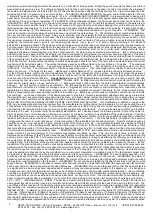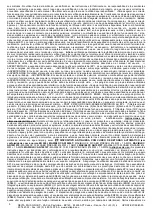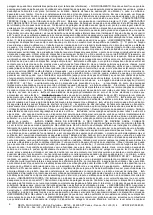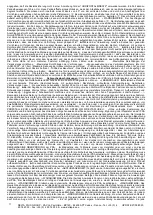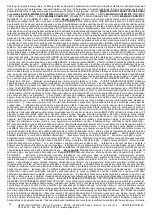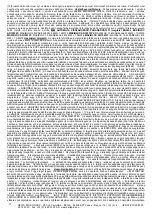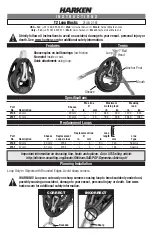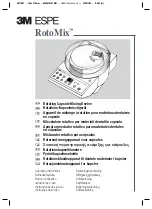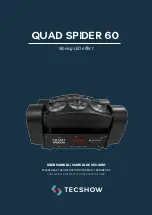
3
DELTA PLUS GROUP - ZAC La Peyrolière - BP140 - 84405 APT Cedex - France - Tel: +33 (0) 4
90 74 20 33 - Fax: +33 (0) 4 90 74 32 59 - www.deltaplus.eu
UPDATE 21/09/2020
vertical movements and large horizontal movements on a horizontal or inclined plane. During the user's movement phases, the cable is
wound and unwound on a drum. The cable is constantly held tight by a return spring. In the case of a fall, a lock blocks the progress of
the cable and instantly stops the initiated fall. For fall arrest devices equipped with the fall indicator function: a red color appears on the
swivel during a fall, or a green color is not more visible. ▪ TECHNICAL CHARACTERISTICS: Lanyard : cable / Rope diameter : Ø4 mm
/ Materials : galvanized steel / Breaking strength :>12 kN. ▪ DONNING AND/ OR ADJUSTMENTS: It is recommended to assign a fall
arrest device for each user. This PPE can only be used by one person at a time. The fall arrest system will be attached to an anchorage
point above the user (minimum resistance: 12 kN (EN795). Unless otherwise indicated, the fall arrest device must not be used in the
"HORIZONTAL USE" configuration. A pendulum movement can occur during a fall. To limit this pendulum movement, the work area or
the lateral movements must be limited. They must not exceed a 40° angle from the vertical axis passing through the anchor point of the
fall arrest device (see diagram).
④
It is recommended not to suddenly drop the cable or strap when it is unwinding. It is best to accompany
it back into the casing.
②
This operation is very important. I
f it is not respected the cable can go out his guide. ▪ WARNINGS: The
device's anchorage point must always be located above or level with the work surface.
③
The attachment point must be located above
the user and the work carried out in such a way, as to minimize both the potential for falls and potential fall distance. A pendulum
movement can occur during a fall. In this case, the force of impact against a structure may cause serious injury or even death. To limit
this pendulum movement, the work area or the lateral movements must be limited. If the work situation requires that these limits be
exceeded, the individual anchor point is not the appropriate device. Use a type C or D anchor device according to the standard
EN795:2012 (example: a lifeline). The deviation of the anchorage device must be taken into account to determine the required clearance.
For this purpose, the information specified in the instructions for use of the anchorage device must be considered. ►During use, ensure
that the devic
e cable is always under tension. ►During use, the overall system must not be in contact with: cutting elements, sharp
edges and structures of small diameter, oils, harsh chemicals, fire, hot metal, all types of electrical conductors... ►For safety reasons
and before each use, check: that the fall indicator (located on the swivel) is not triggered (the red colour should not appear, or the green
color is still apparent). that the connectors (EN362) are closed and locked / that the operating instructions described for each component
of the system are met / that the general disposition of the work situation reduces the fall risk, the drop height and the pendulum movement
in the case of a fall. / that the vertical clearance is sufficient (free space beneath the feet of the user) and no obstacles disrupt the normal
functioning of the fall arrest system. The vertical clearance depends on different factors, but not limited to, it includes: -The maximum
deflection of the anchorage device. -The maximum deflection of the carabiners. -The elongation of the linking system. (H value)
(AN100XXY : H=1.5m) -The maximum stretch of the body supporting device. -The anchorage location relative to where the user is
when a fall occurs. -The height of the user. -Additionally, a safety distance of 1 m is added to obtain the vertical clearance value. -
For the different factors, refer to the recommendations for use for each component of the system. Ensure that proper fall clearance
exists in order to prevent stri
king ground or other objects in the event of a fall. ►Provide a safe distance from the ground and the power
lines or areas with an electrical hazard.
Usage limits:
Before any PPE implementation operation, set up a rescue plan to deal with
any emergenc
y that may occur during the operation. ▪ SHELF LIFE: ►Metal products and mechanical products (self retracting fall
arrest device, sliding, work on ropes, anchors etc. ...) : Maximum duration of 20 years from the date of manufacture (including storage
a
nd use). ►The shelf life is given as an indication. The following factors can cause it to vary greatly: -Non-compliance with the
manufacturer's instructions for transport, storage and use /-"Aggressive" work environment: marine atmosphere, chemicals, extreme
temperatures, sharp edges... /-Particularly intensive use /-Shock or significant constraint /-Disregard for the product item's history.
Warning: these factors can cause damage invisible to the naked eye. ►Warning: certain extreme conditions can shorten the shelf life
by a few days. ▪In the case of doubt or if the device was used to stop a fall, it must be immediately withdrawn from use and returned to
the manufacturer or any competent person appointed by them. ▪If in doubt, always remove the product for it to undergo either: - a review
/- destruction. The shelf life is not a substitute for periodic verification (minimum annually) which will assess the condition of the product.
►TO FIND YOUR LOCAL ANNUAL REVIEW CENTRE, VISIT WWW.DELTAPLUS.EU. ▪No modification or addition or repair of the
PPE may be made without prior written consent from the manufacturer nor without using their procedures. Do not use beyond the area
of use defined in the instructions for use. The manufacturer cannot be held liable for any direct or indirect accident after a modification or
use other than that provided in this manual. Do not use this equipment beyond its limits. ▪To ensure its working condition and therefore
the safety of the user, the product must be checked sys
tematically: ►1 / visually inspect the following points: / State of the cable: no
start of rupture of one or more threads, no folding, no burning, no corrosion or oxidation, no deformation of the cable stranding. / Condition
of the metal parts: no wear, no deformation, no corrosion or oxidation. /General condition: look for any possible damage due to ultraviolet
radiation and other climatic conditions / Correct operation and locking of connectors . / That the fall indicator (located on the swivel) is
not triggered (the red color must not appear). / Correct operation of the retractable function and cable lock. / Specific conditions such as
humidity, snow, ice, mud, dirt, paint, oil, glue, corrosion, wear of the strap or rope, etc..., can significantly reduce the operation of the fall
arrest device. ►2 / in the following cases: Before and during use / if in doubt / In the case of contact with chemicals, solvents or fuels
that could affect operation. / If it has been subjected to stress during a previous fall. / At least every twelve months by the manufacturer
or a competent organization, mandated by them. ▪ PERIODIC REVIEW of PPE: ►An examination must be performed at least every
twelve months by the manufacturer or a competent organization, mandated by them. This very important check is related to the
maintenance and efficacy of the PPE and hence the user's safety. A written document authorising reuse should be obtained during this
audit in order to reuse the PPE. This document will clarify that the user's safety is linked to maintaining the efficiency and resistance of
the equipment. ►Repair or replace the PPE if necessary. ►In accordance with European regulations, the identification form must be
completed prior to the first use of the product and then
updated and kept with the product as well as the manual by the user. ►The
readability of the product labelling must be checked periodically. It is very important to do this operation, to check all components and
assembly inside the product, and to be sur
e about the correct functioning. ▪FALL INDICATOR: (14) ►When the fall indicator is activated,
the red color appears (or the green color disappears in the case of the T connector) : do not use the fall arrest device. Have the fall arrest
device inspected and checked the by the manufacturer or a competent organization, mandated by them. The fall indicator swivel must
be replaced. In these cases, follow the instructions described in their own manual. •• WARNINGS: The user's safety depends on the
continuing
efficacy of the PPE, its strength and the proper understanding of the instructions in this manual. ▪WARNINGS: Any static or
dynamic overload may damage the PPE. ▪WARNINGS: The weight of the user, including his clothing and equipment must not exceed
the
maximum weight indicated on the fall arrest. ▪WARNINGS: Do not use the self retracting fall arrest device as a restraint or work
support device. ▪WARNINGS: In the case of contact with chemicals, solvents or fuels that could affect the operation, take the fall arrest
device out of service. Have it inspected and revised before use. ▪WARNINGS: Do not use a fall arrest device that has been subjected
to a significant drop before it has been inspected and checked as it may undergone damage invisible to the
naked eye. ▪ It is dangerous
to create your own personal fall protection system as each safety function may interfere with another safety function. ▪No modification
or addition or repair of the PPE may be made without prior written consent from the man
ufacturer without using their procedures. ▪Do
not use beyond the scope of
use defined in the usage instructions, nor beyond its limits. ▪The manufacturer cannot be held liable for any
direct or indirect accident after a modification or use other than t
hat provided in this manual. ►Temperature of working environment : -
32°C / +50°C. ▪RISK ANALYSIS : EN360 : The device is a personal protective equipment against falls from a height: it protects the
user against this risk only when it used in a complete fall arrest system (EN363), which limit the peak of load during a fall to 6 kN. The
use of these PPE is reserved for competent persons who have received appropriate training or who are operating under the imme diate
responsibility of a competent superviso
r, therefore the misuses is reduced to a minimum. ▪ PART 2: RECORD CARD :PERIODIC
REVIEW of PPE: (1)Reference of the product (2)Company (3)User Name (4)The batch number,/Serial N° (5)Production date (6)Date
of 1st Use (7)Purchase date (8)Date of inspection (9)Comments (10)Date of next inspection (11)Name & Signature (12)Date of next
inspection (13)Type Personal protective equipment (14)The record card must be completed by the user before the product is first used,
then regularly updated and kept. To be exclusively used as described in the product user instructions. (15)The frequency of inspections
must comply with national regulations and in any case an inspection must be performed at least once a year. The documentation supplied



